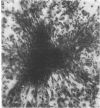Abstract
Cellular subpopulations having two of the growth properties of neoplastically transformed cells--lack of postconfluence inhibition of cell division (CI-) and anchorage independence of growth (AD-)--were found in cell cultures established from 10- to 13-day-old Syrian hamster embryos. The subpopulations having these properties decrease with increasing gestation period of the embryo as well as with continuing passage in vitro. The decrease in these subpopulations was also observed when they were cultured on a lethally irradiated confluent monolayer of contact-inhibited cells (cell mat), a selection condition for CI- cells. Therefore, negative selection cannot be the explanation for the loss of CI- cells in the population, leaving two other possibilities: either the loss of proliferative capacity of the CI- cells or the acquisition of sensitivity to postconfluence inhibition of cell division (CI+) of this subpopulation on in vitro culture or in vivo growth. The CI- subpopulations were isolated clonally from cell mats and were cultured continuously on both cell mats or plastic dishes. The results indicate that these cells did not lose proliferative capacity but acquired the contact-inhibited phenotype. This result, together with the fact that embryonic development in vivo also decreases CI/AD-subpopulations, suggests that the disappearance of these subpopulations is due to cellular differentiation of the CI-/AD- cells to become CI+/AD+ cells.
Full text
PDF
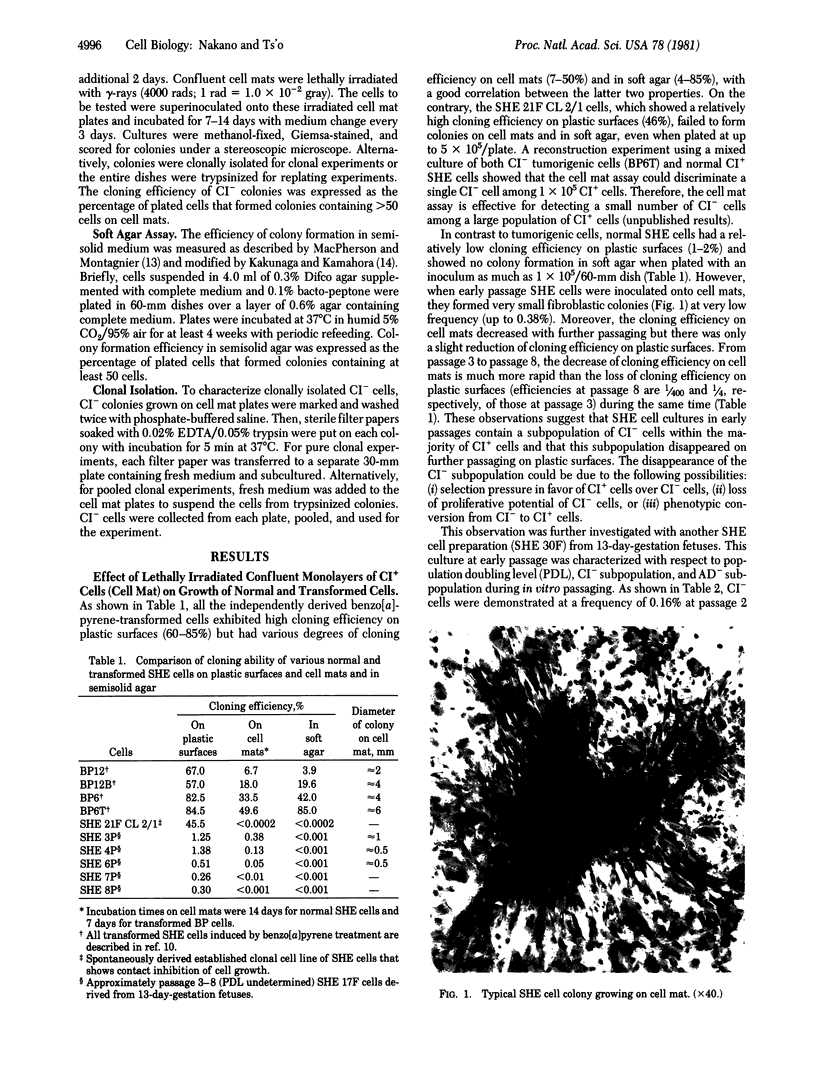
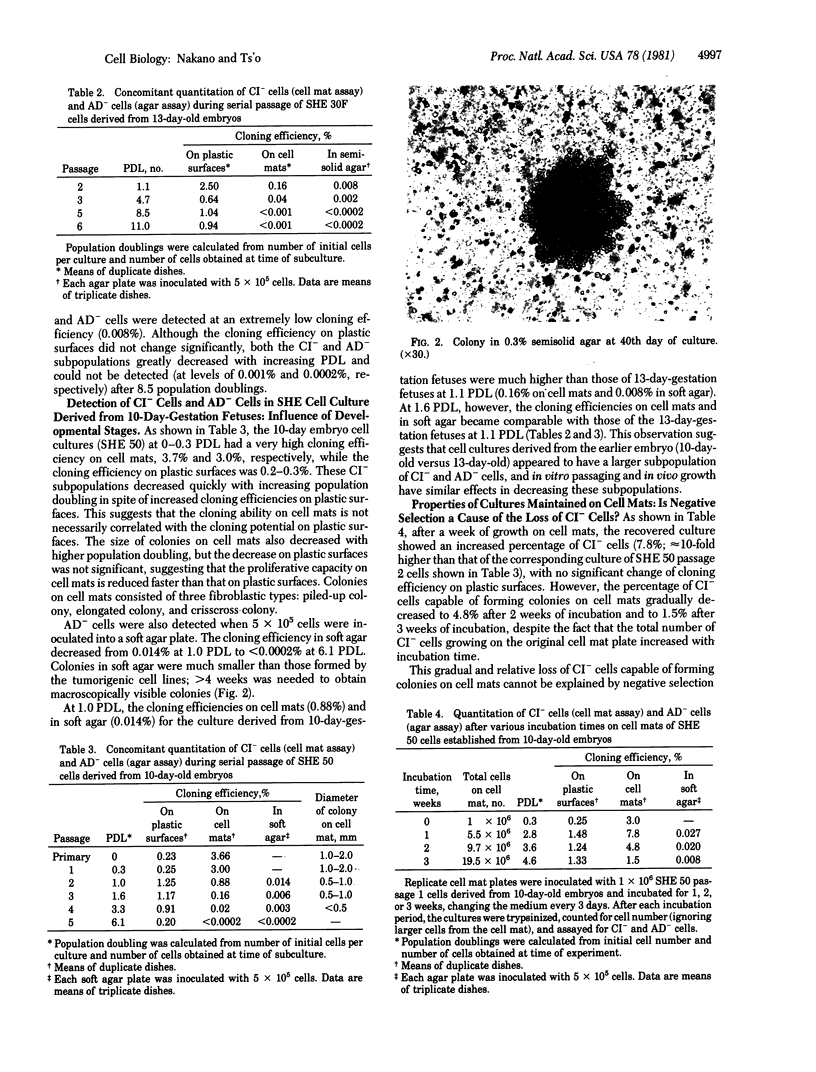
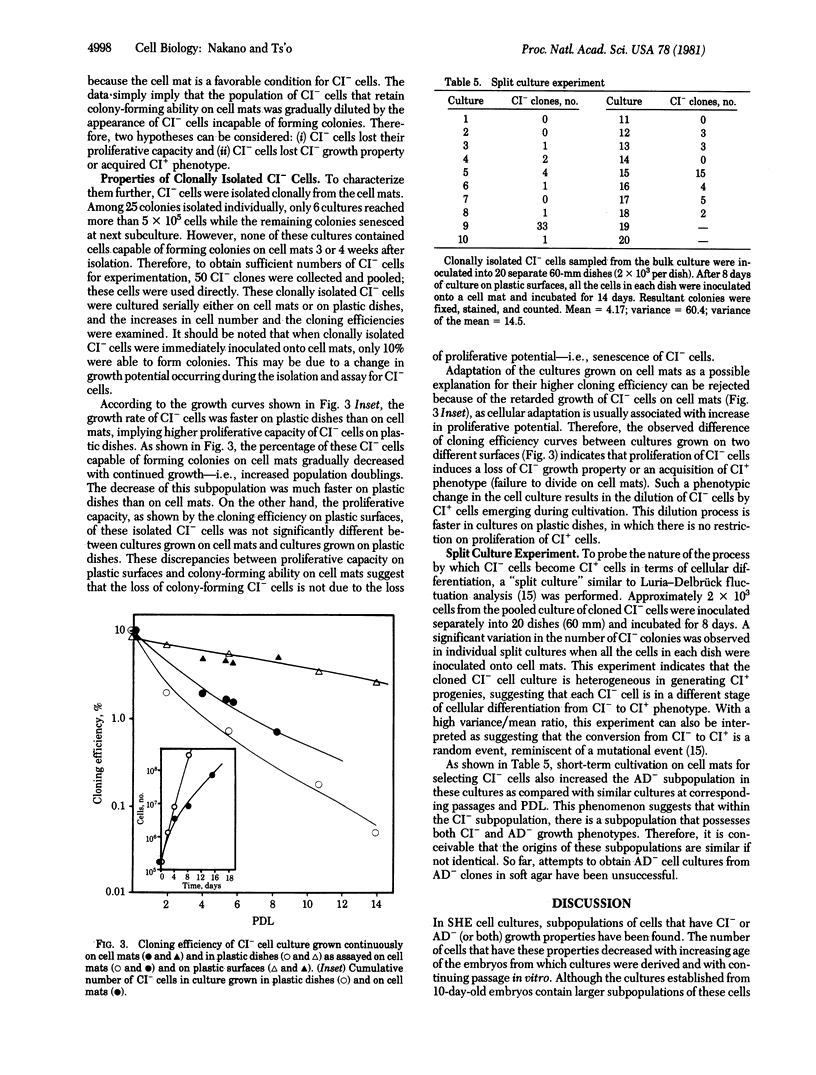
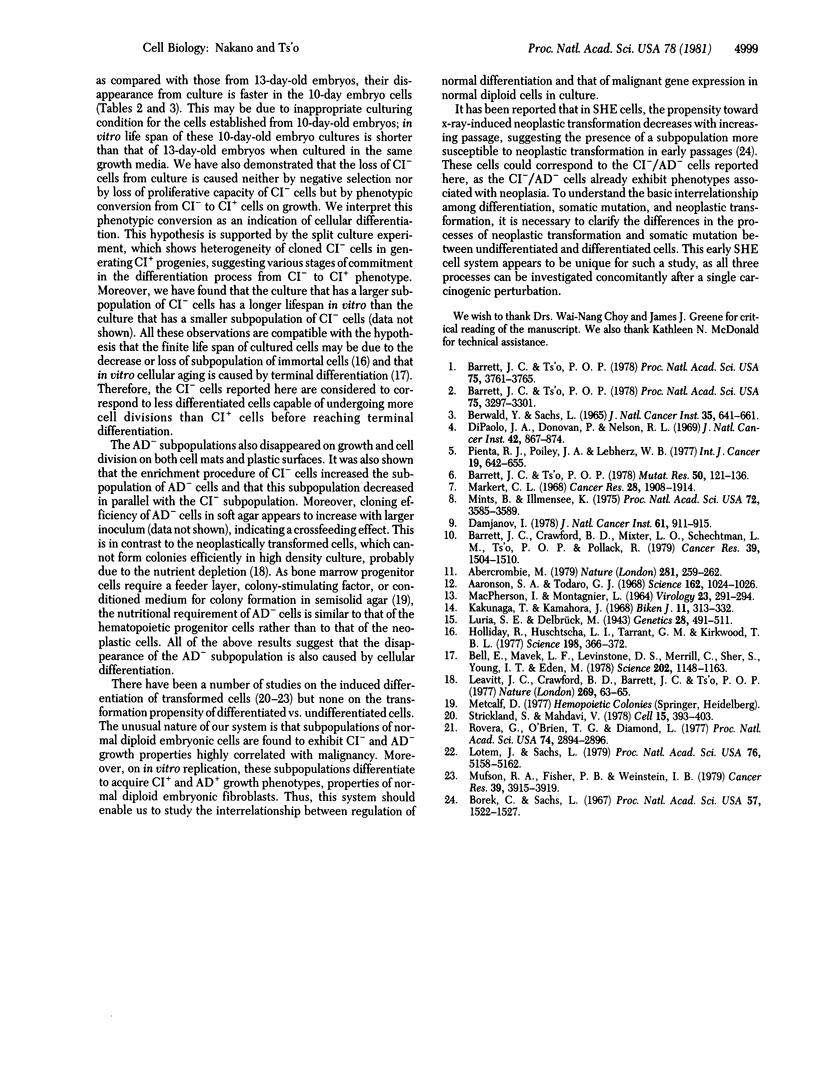
Images in this article
Selected References
These references are in PubMed. This may not be the complete list of references from this article.
- Aaronson S. A., Todaro G. J. Basis for the acquisition of malignant potential by mouse cells cultivated in vitro. Science. 1968 Nov 29;162(3857):1024–1026. doi: 10.1126/science.162.3857.1024. [DOI] [PubMed] [Google Scholar]
- Abercrombie M. Contact inhibition and malignancy. Nature. 1979 Sep 27;281(5729):259–262. doi: 10.1038/281259a0. [DOI] [PubMed] [Google Scholar]
- Barrett J. C., Bias N. E., Ts'o P. O. A mammalian cellular system for the concomitant study of neoplastic transformation and somatic mutation. Mutat Res. 1978 Apr;50(1):121–136. doi: 10.1016/0027-5107(78)90067-2. [DOI] [PubMed] [Google Scholar]
- Barrett J. C., Crawford B. D., Mixter L. O., Schechtman L. M., Ts'o P. O., Pollack R. Correlation of in vitro growth properties and tumorigenicity of Syrian hamster cell lines. Cancer Res. 1979 May;39(5):1504–1510. [PubMed] [Google Scholar]
- Barrett J. C., Ts'o P. O. Evidence for the progressive nature of neoplastic transformation in vitro. Proc Natl Acad Sci U S A. 1978 Aug;75(8):3761–3765. doi: 10.1073/pnas.75.8.3761. [DOI] [PMC free article] [PubMed] [Google Scholar]
- Barrett J. C., Ts'o P. O. Relationship between somatic mutation and neoplastic transformation. Proc Natl Acad Sci U S A. 1978 Jul;75(7):3297–3301. doi: 10.1073/pnas.75.7.3297. [DOI] [PMC free article] [PubMed] [Google Scholar]
- Bell E., Marek L. F., Levinstone D. S., Merrill C., Sher S., Young I. T., Eden M. Loss of division potential in vitro: aging or differentiation? Science. 1978 Dec 15;202(4373):1158–1163. doi: 10.1126/science.725592. [DOI] [PubMed] [Google Scholar]
- Berwald Y., Sachs L. In vitro transformation of normal cells to tumor cells by carcinogenic hydrocarbons. J Natl Cancer Inst. 1965 Oct;35(4):641–661. [PubMed] [Google Scholar]
- Borek C., Sachs L. Cell susceptibility to transformation by x-irradiation and fixation of the transformed state. Proc Natl Acad Sci U S A. 1967 May;57(5):1522–1527. doi: 10.1073/pnas.57.5.1522. [DOI] [PMC free article] [PubMed] [Google Scholar]
- Damjanov I. Development of teratomas from embryos transplanted into outbred and inbred adult hamsters. J Natl Cancer Inst. 1978 Sep;61(3):911–915. [PubMed] [Google Scholar]
- DiPaolo J. A., Donovan P., Nelson R. Quantitative studies of in vitro transformation by chemical carcinogens. J Natl Cancer Inst. 1969 May;42(5):867–874. [PubMed] [Google Scholar]
- Holliday R., Huschtscha L. I., Tarrant G. M., Kirkwood T. B. Testing the commitment theory of cellular aging. Science. 1977 Oct 28;198(4315):366–372. doi: 10.1126/science.910134. [DOI] [PubMed] [Google Scholar]
- Kakunaga T., Kamahora J. Properties of hamster embryonic cells transformed by 4-nitroquinoline-1-oxide in vitro and their correlations with the malignant properties of the cells. Biken J. 1968 Dec;11(4):313–332. [PubMed] [Google Scholar]
- Leavitt J. C., Crawford B. D., Barrett J. C., Ts'o P. O. Regulation of requirements for anchorage-independent growth of Syrian hamster fibroblasts by somatic mutation. Nature. 1977 Sep 1;269(5623):63–65. doi: 10.1038/269063a0. [DOI] [PubMed] [Google Scholar]
- Lotem J., Sachs L. Regulation of normal differentiation in mouse and human myeloid leukemic cells by phorbol esters and the mechanism of tumor promotion. Proc Natl Acad Sci U S A. 1979 Oct;76(10):5158–5162. doi: 10.1073/pnas.76.10.5158. [DOI] [PMC free article] [PubMed] [Google Scholar]
- Luria S. E., Delbrück M. Mutations of Bacteria from Virus Sensitivity to Virus Resistance. Genetics. 1943 Nov;28(6):491–511. doi: 10.1093/genetics/28.6.491. [DOI] [PMC free article] [PubMed] [Google Scholar]
- MACPHERSON I., MONTAGNIER L. AGAR SUSPENSION CULTURE FOR THE SELECTIVE ASSAY OF CELLS TRANSFORMED BY POLYOMA VIRUS. Virology. 1964 Jun;23:291–294. doi: 10.1016/0042-6822(64)90301-0. [DOI] [PubMed] [Google Scholar]
- Markert C. L. Neoplasia: a disease of cell differentiation. Cancer Res. 1968 Sep;28(9):1908–1914. [PubMed] [Google Scholar]
- Mintz B., Illmensee K. Normal genetically mosaic mice produced from malignant teratocarcinoma cells. Proc Natl Acad Sci U S A. 1975 Sep;72(9):3585–3589. doi: 10.1073/pnas.72.9.3585. [DOI] [PMC free article] [PubMed] [Google Scholar]
- Mufson R. A., Fisher P. B., Weinstein I. B. Effect of phorbol ester tumor promoters on the expression of melanogenesis in B-16 melanoma cells. Cancer Res. 1979 Oct;39(10):3915–3919. [PubMed] [Google Scholar]
- Pienta R. J., Poiley J. A., Lebherz W. B., 3rd Morphological transformation of early passage golden Syrian hamster embryo cells derived from cryopreserved primary cultures as a reliable in vitro bioassay for identifying diverse carcinogens. Int J Cancer. 1977 May 15;19(5):642–655. doi: 10.1002/ijc.2910190508. [DOI] [PubMed] [Google Scholar]
- Rovera G., O'Brien T. G., Diamond L. Tumor promoters inhibit spontaneous differentiation of Friend erythroleukemia cells in culture. Proc Natl Acad Sci U S A. 1977 Jul;74(7):2894–2898. doi: 10.1073/pnas.74.7.2894. [DOI] [PMC free article] [PubMed] [Google Scholar]
- Strickland S., Mahdavi V. The induction of differentiation in teratocarcinoma stem cells by retinoic acid. Cell. 1978 Oct;15(2):393–403. doi: 10.1016/0092-8674(78)90008-9. [DOI] [PubMed] [Google Scholar]



